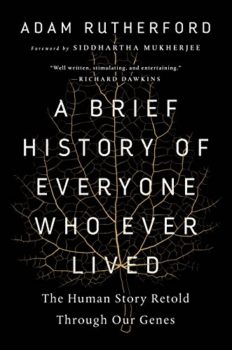
There is no gene for evil. Black people have no genetic predisposition to excel at sports. Tay-Sachs is not a Jewish disease. Native Americans are not genetically predisposed to alcoholism. And, of course, there is no such thing as a “race” in genetics. These are a few of the many popular myths Adam Rutherford explodes in his ambitious new book, A Brief History of Everyone Who Ever Lived: The Human Story Retold Through Our Genes.
Estimated reading time: 5 minutes
Rutherford’s book consists of two parts. Part One, “How We Came to Be,” lives up to the title for the most part. He outlines the emergence of Homo sapiens as the sole survivor of several human species. (All members of the genus Homo are human. This includes Neanderthals, Denisovans, Homo erectus, and an as yet unknown number of other species.)
Using the latest findings from genetic research, the author traces the movements of various human populations over 200,000 years since the first anatomically modern human walked the Earth. Rutherford emphasizes that the patterns of migration were far more complex than earlier studies have led us to believe—and interbreeding among human species far more extensive.
A Brief History of Everyone Who Ever Lived: The Human Story Retold Through Our Genes by Adam Rutherford ★★★★☆
Debunking popular myths
In Part Two, “Who We Are Now,” Rutherford departs from the promise of the title to survey the findings of genetic research about some of the many popular misconceptions about race and genetics. Here are a few highlights:
- Are African-Americans uniquely well-suited to play basketball? Not so, he writes. “The Dutch are the tallest people on average on Earth, and I have little doubt that if there were similar numbers of Dutch people as there are Americans, and basketball were as culturally important and ubiquitous, then they would produce teams as good as the LA Lakers.”
- Do some people commit awful crimes because their genes program them to do so? “No one will ever find a gene for ‘evil,’ or for beauty, or for musical genius, or for scientific genius, because they don’t exist. DNA is not destiny.”
- What about that “Jewish disease” Tay-Sachs? “Tay-Sachs . . . is seen at roughly the same frequency in Cajuns in Louisiana, and French Canadians in Quebec. There is no such thing as a Jewish disease, because Jews are not a genetically distinct group of people.”
What about race? The visible differences between, say, East Asians and Africans suggest that races are real, don’t they? Well, no. Not at all. As Rutherford makes clear, “certain genetic groupings do roughly correspond to geography. But not exclusively, and not essentially.” There is, in fact, no such thing as “race” in genetics. “Eighty-five percent of human variation, according to the genetic differences in blood groups,” Rutherford writes, “was seen in the same racial groups. Of the remaining 15 percent, only 8 percent accounted for differences between one racial group and another.”
Visible “racial” differences are genetically trivial
In other words, those visible differences among the races are trivial from a genetic perspective. The genetic differences among any two Africans from different parts of the continent are almost certainly greater than the differences between either of them and a pale, blond, blue-eyed Scandinavian. This should be obvious to anyone with even a rudimentary grasp of genetics, Rutherford suggests. When Homo sapiens began migrating out of Africa and radiating around the world, only small groups left the motherland. The genetic diversity among them was immeasurably smaller than that of the much larger numbers they left behind.
The author explains at length that the Human Genome Project did not decode the whole genome. In fact, more than 98 percent of the three billion letters on the genome do not encode for proteins, which is the primary function of genes. These non-coding letters have been given the unfortunate and misleading name of “junk DNA.” Many do have discernible and important functions. But the function of most junk DNA is not understood.
No diseases have yet been eradicated through genetics
Scientists are in the very earliest stages of tapping the power of genetics to address disease. As of now, “the number of diseases that have been eradicated as a result of our knowing the genome? Zero. The number of diseases that have been cured as a result of gene therapy? Zero.” The Human Genome Project was a beginning, not an end. Today, “DNA is used routinely in the diagnosis of dozens of cancers, of heart arrhythmias, in identifying the causes of thousands of diseases too rare to have historically warranted major research projects.” But science today is merely scratching the surface of this potential.
Rutherford clearly knows his stuff. But he’s far from infallible. He’s dismissive of linguistic studies that inform our understanding of prehistorical migration patterns. Why? He doesn’t explain. He’s inconsistent about the number of years when Homo sapiens first entered the Americas, citing numbers all the way from 12,000 years to more than 24,000.
He refers on numerous occasions to findings from the for-profit companies 23andme and BritainsDNA, both of which provide genetic profiles to individuals for a price. But he fails to mention the National Geographic Genographic Project, which predates them both and now encompasses genetic records from more than 800,000 people. And he first states that individuals from different species can’t mate and produce fertile offspring, then fails to explain how Homo sapiens and Neanderthals together produced so many of the rest of us.
British geneticist and broadcaster Adam Rutherford is a former editor of the journal Nature. He hosts the BBC Radio 4 program Inside Science.
For related reading
This is one of the books I’ve included in my post, Gaining a global perspective on the world around us.
This is also one of the many Good books about racism. You might also enjoy Science explained in 10 excellent popular books.
If you enjoy reading nonfiction in general, you might also enjoy:
- Great biographies I’ve reviewed: my 10 favorites
- My 10 favorite books about business history
- 20 top nonfiction books about history
And you can always find my most popular reviews, and the most recent ones, on the Home Page.


























